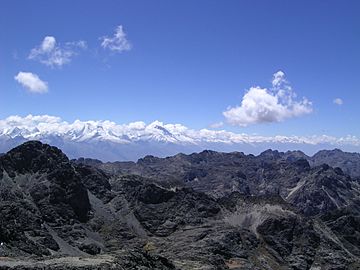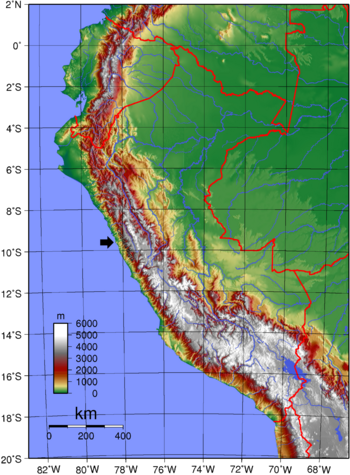Cordillera Negra facts for kids
Quick facts for kids Cordillera Negra |
|
|---|---|

Part of the Cordillera Negra with the Cordillera Blanca in the background as seen from Qarwaqucha
|
|
| Highest point | |
| Peak | Quñuqranra |
| Dimensions | |
| Length | 230 km (140 mi) N-S |
| Geography | |
| Country | Peru |
| State/Province | Ancash Region |
| Parent range | Andes |
The Cordillera Negra is a mountain range in Peru. Its name means "Black Range" in Spanish, and it's called Yana Walla in Quechua. This range is part of the Cordillera Occidental, which is one of three main mountain ranges in the Andes mountains of west-central Peru. You can find almost all of it within the Ancash Region.
This mountain range stretches for about 230 kilometers (143 miles) and is 25–40 kilometers (15–25 miles) wide. It runs from north-northwest to south-southeast, parallel to the Pacific coast. Its highest ridge is about 60 kilometers (37 miles) from the coastline. The Cordillera Negra is part of the larger Andes mountain system. It borders the narrow strip of coastal deserts along the South American coast.
To the north and east, the Santa River forms its border. This river crosses the coastal ridge and runs alongside the Cordillera Negra for most of its length. To the south, the Patiwillka River marks its end. In the middle of the range, near Huaráz, the Casma River cuts through the mountains.
The Cordillera Negra has rocky peaks that get very little snow, even in winter. The deep valleys, called gullies, often look dark and gloomy. Most of these valleys are dry, or their rivers have very little water flowing through them.
The Santa River separates the Cordillera Negra from the Cordillera Blanca. The Cordillera Blanca is a snow-covered range that rises much higher, up to 6,768 meters (22,205 feet). Even though the Cordillera Negra reaches 5,181 meters (16,998 feet) at its highest point, it usually has no snow for most of the year. This is because it blocks the warm air coming from the Pacific Ocean, which causes the permanent snow line in the nearby Cordillera Blanca to be as low as 5,100 meters (16,732 feet).
Today, not many people live in the Cordillera Negra. The people who do live there are mostly indigenous. They grow crops like wheat, maize (corn), and oats at very high elevations, often above 4,000 meters (13,123 feet). The mountains are also rich in valuable minerals such as gold, silver, and copper.
Contents
Exploring the Mountains of Cordillera Negra
The highest mountain in the Cordillera Negra is Quñuqranra, which stands at 5,181 meters (16,998 feet) tall. Many other mountains are part of this range.
- Kankawa, 5,102 metres (16,739 ft)
- Qarwaqucha, 5,070 metres (16,634 ft)
- Rumi Cruz, 5,020 metres (16,470 ft)
- Cerro Rico, 5,006 metres (16,424 ft)
- Akapa Ranin, 5,000 metres (16,404 ft)
- Kushuru, 5,000 metres (16,404 ft)
- Q'iruqucha, 5,000 metres (16,404 ft)
- Wank'ap'iti, 4,976 metres (16,325 ft)
- Puka Hirka, 4,870 metres (15,978 ft)
- Chunta, 4,810 metres (15,781 ft)
- Ichik Wiri, 4,800 metres (15,748 ft)
- Kankawa Punta, 4,800 metres (15,748 ft)
- Kushuru Punta, 4,800 metres (15,748 ft)
- Mashma Chaka, 4,800 metres (15,748 ft)
- Mata Mata, 4,800 metres (15,748 ft)
- Millishqucha, 4,800 metres (15,748 ft)
- Millpuq, 4,800 metres (15,748 ft)
- Parya, 4,800 metres (15,748 ft)
- Pillaka, 4,800 metres (15,748 ft)
- Puka Allpa, 4,800 metres (15,748 ft)
- Puka Punta, 4,800 metres (15,748 ft)
- Shinwaqucha, 4,800 metres (15,748 ft)
- Simiyuq Wank'a, 4,800 metres (15,748 ft)
- Yana Yaku, 4,800 metres (15,748 ft)
- Wanaku, 4,800 metres (15,748 ft)
- Yana Mach'ay, 4,800 metres (15,748 ft)
- Yuraq Punta, 4,800 metres (15,748 ft)
- Puka Qaqa, 4,640 metres (15,223 ft)
- Chunta Punta, 4,600 metres (15,092 ft)
- Kima Tullpa, 4,600 metres (15,092 ft)
- Kiswar, 4,600 metres (15,092 ft)
- Kunkush, 4,600 metres (15,092 ft)
- Kunkush Kancha, 4,600 metres (15,092 ft)
- Kuntur Qaqa, 4,600 metres (15,092 ft)
- Kushuru Hirka, 4,600 metres (15,092 ft)
- Lima Hirka, 4,600 metres (15,092 ft)
- Minas Hirka, 4,600 metres (15,092 ft)
- Parya, 4,600 metres (15,092 ft)
- Puka Hirka, 4,600 metres (15,092 ft)
- Puka Ranra, 4,600 metres (15,092 ft)
- Pukaqucha, 4,600 metres (15,092 ft)
- Puma Puñunan, 4,600 metres (15,092 ft)
- Phiruru Punta, 4,600 metres (15,092 ft)
- Qaqa Rumi Kunka, 4,600 metres (15,092 ft)
- Qulluta, 4,600 metres (15,092 ft)
- Sach'a Hirka, 4,600 metres (15,092 ft)
- Simiyuq Wank'a, 4,600 metres (15,092 ft)
- Ututu Hirka, 4,600 metres (15,092 ft)
- Wallpaq Sillu Punta, 4,600 metres (15,092 ft)
- Wishka, 4,600 metres (15,092 ft)
- Yana Kunkush, 4,600 metres (15,092 ft)
- Yana Mach'ay, 4,600 metres (15,092 ft)
- Yanaqucha, 4,600 metres (15,092 ft)
- Hatun Kunka, 4,400 metres (14,436 ft)
- Isku Pata, 4,400 metres (14,436 ft)
- Puma Wayin, 4,400 metres (14,436 ft)
- Qullpa Hirka, 4,200 metres (13,780 ft)
- Tarush Qhawana, 4,400 metres (14,436 ft)
- T'uquyuq, 4,400 metres (14,436 ft)
- Wamp'u, 4,400 metres (14,436 ft)
- Yuraq Yaku, 4,400 metres (14,436 ft)
- Kuntur Wayin, 4,200 metres (13,780 ft)
- Putaqa, 4,200 metres (13,780 ft)
- Llaksa Hirka, 4,000 metres (13,123 ft)
- Wamp'u, 4,000 metres (13,123 ft)
- Hatun Hirka, 3,400 metres (11,155 ft)
The highest road pass in the Cordillera Negra is the Wank'ap'iti pass. It is located at 4,680 meters (15,354 feet) above sea level.
Roads and Travel in the Cordillera Negra
The road from Casma to Huaraz is not a very busy one. It starts as a paved road that goes up to Yaután. After that, it quickly becomes an unpaved path. This path climbs along the sides of the Cordillera Negra, following the path of the Casma River. The route gets even steeper when it reaches Pariacoto.
Along this road, there are not many large towns. The town of Pira is one of the few places that offers services for travelers. This route is very steep and narrow, winding between huge cliffs and deep gullies. As you travel, you can see small rural areas with chakras, which are small farms. On these farms, people grow crops like potatoes, wheat, barley, and other foods. You can also see livestock and a lot of human activity in these areas.
Discovering Guitarrero Cave
In the 1960s, an important discovery was made on the northern edge of the Cordillera Negra: the Guitarrero Cave. This cave contained bones from ancient animals like mastodons and llamas. More importantly, it showed signs that humans lived there a very long time ago, between 10,950 and 10,230 BC. This makes it one of the oldest known sites of human occupation in the Americas!
See also
 In Spanish: Cordillera Negra para niños
In Spanish: Cordillera Negra para niños


